Typically, when we bite into an apple, we expect a crisp white interior. However, a unique group of apples known as red-fleshed or blood apples, defy this expectation. These intriguing fruits, often with a tantalizing deep red or pink inner hue, offer a new and exciting world of flavors and health benefits. Originating from wild apple varieties, they have been further developed with the help of modern breeding techniques to enhance their distinct characteristics. The red coloring is due to the presence of pigments called anthocyanins, which are powerful antioxidants, and not a result of oxidation or stress factors. This article aims to explore the red-fleshed apple varieties, the science behind this fascinating phenomena, their healthful impact, culinary uses, and the adventure of growing them.
Overview of Red-Fleshed Apples
Overview of Red-Fleshed Apples
Red-fleshed apples are not your typical apples; they exhibit a visually rich, red interior rather than the conventional white or cream-colored flesh that most apple types possess. The variety of apple that has a red interior is termed a red-fleshed apple. Not only is this fascinating to look at, but it also offers a different flavor profile and additional health benefits.
These unusual types of apples get their red color from a high concentration of anthocyanins. Anthocyanins are a type of flavonoid, a class of compounds with antioxidant effects. Found naturally in a number of foods, anthocyanins are what give these apples their signature red color, both inside and out.
Genetic Factors Contribute to Red Flesh
The first red-fleshed apples were discovered growing wild in Central Asia thousands of years ago. These unique types were naturally occurring mutations. Since then, breeders have worked to select and develop them.
The gene responsible for the red color in apple flesh was long thought to be a result of chance mutations. Only in recent years have scientists discovered that the development of red-fleshed apples is the result of inserting a specific gene into the apple’s genome. This gene allows for the production of more anthocyanins, which imparts the vibrant red color to the apple’s flesh.
Varieties of Red-Fleshed Apples
There are now several cultivated varieties of these apples available, including the aptly named Redlove, a Swiss variety known for its dark red flesh and sweet-tart taste. The Surprise apple is a Canadian variety that looks like a typical green apple from the outside, but boasts bright pink-red flesh inside.
Each variety has its own specific taste, ranging from sweet to tart, making these apples suitable for a variety of culinary uses. Some are ideal for eating fresh, while others, with more tart profiles, lend themselves well to baked goods or cider-making.
Benefits of Red-Fleshed Apples
In addition to their aesthetic appeal and unique flavor, red-fleshed apples are also rich in anthocyanins, a type of flavonoid with numerous health benefits. They are known to have antioxidant properties, that can protect the body from damage by free radicals. They may also contribute to a reduced risk of heart disease, cancer, and other conditions.
A Closer Look at Red-Fleshed Apples
Red-fleshed apples, though less common than their traditional counterparts, bring forward a remarkable blend of flavor, health benefits, and aesthetic appeal. From the outside, they appear to be regular apples, but a bite reveals an enticingly vibrant red core. So, while shopping for apples, perhaps be on the lookout for these unique varieties and have a taste of red-fleshed apples.
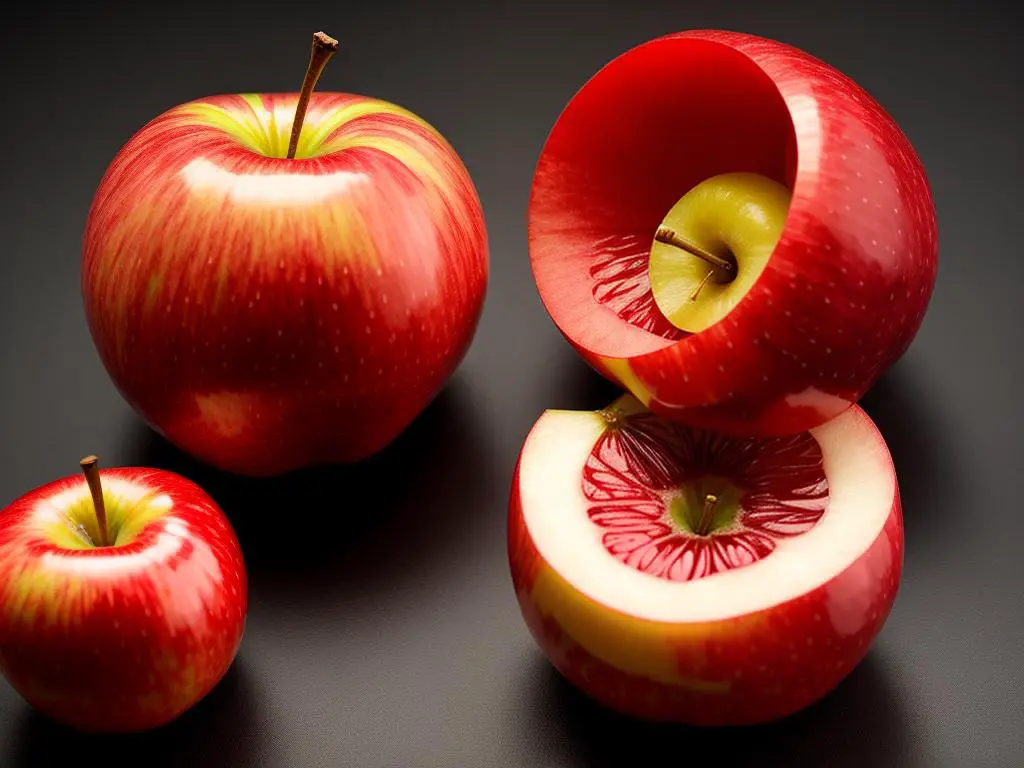
Science Behind the Red Flesh in Apples
Decoding the Science of Red Flesh in Apples
When it comes to red-fleshed apples such as the ‘Redlove’ and ‘Rosetta’ varieties, the red interior isn’t just fascinating aesthetically, but also carries distinctive flavors and health benefits. The origins of the red color lie in the activation of certain specific genes during the apple’s development, accompanied by the presence of a pigment group responsible for the vibrant colors in most fruits and flowers.
The Role of Anthocyanins in Apples
Anthocyanins are the group of pigments responsible for the red, purple, or blue hues in many fruits, flowers, and even leaves. They belong to the class of compounds known as flavonoids, which are prevalent throughout the plant kingdom. In apple fruits, anthocyanins are responsible for both skin and flesh color, depending on the variety.
In red-fleshed apple varieties, two different genes need to be activated to produce the anthocyanin pigments within the apple’s flesh. In other words, both genes function like a dual key system that, when activated, unlocks the pathway for anthocyanin synthesis, thereby turning the apple’s flesh red.
The Effect of Environmental Factors
Aside from the genetic makeup of the apple, environmental factors can also contribute to the color of an apple’s flesh. Sunlight, temperature, and weather stressors are known to influence anthocyanin development and, therefore, the vibrancy of an apple’s red color.
Bright sunlight and cool temperatures can encourage the production of anthocyanins as a type of plant sunscreen and a form of protection against chilling injury. Similarly, various types of stress, such as drought or nutrient deficiency, can trigger the plant to produce anthocyanins as a response mechanism.
Oxidation Process in Apples
When an apple is cut or bitten into, a process called oxidation occurs. Oxidation is a chemical reaction that happens when the apple’s cells are exposed to oxygen. During this process, enzymes present in the apple’s flesh convert phenolic compounds into o-quinones, which then react further, producing a mixture of compounds that tend to have brown colors. This is why apples turn brown inside when left exposed to air.
However, some apple varieties, particularly those with red flesh, do not turn brown as quickly due to their high anthocyanin content. It appears that the anthocyanins, which are powerful antioxidants themselves, can protect the other pigments in the apple from the effects of oxidation.
Understanding Red Inside Apples
Unlike common varieties, some apples exhibit a red color on the inside. The reasons are accredited to a mix of specific genes triggering to activate, the pigmentation called anthocyanin, external environmental factors, and the responses given by the apple internally when interacting with oxygen. But, there’s more to them than meets the eye; these red-fleshed apples have high anthocyanin content, which is said to provide an array of health benefits to those who consume them.
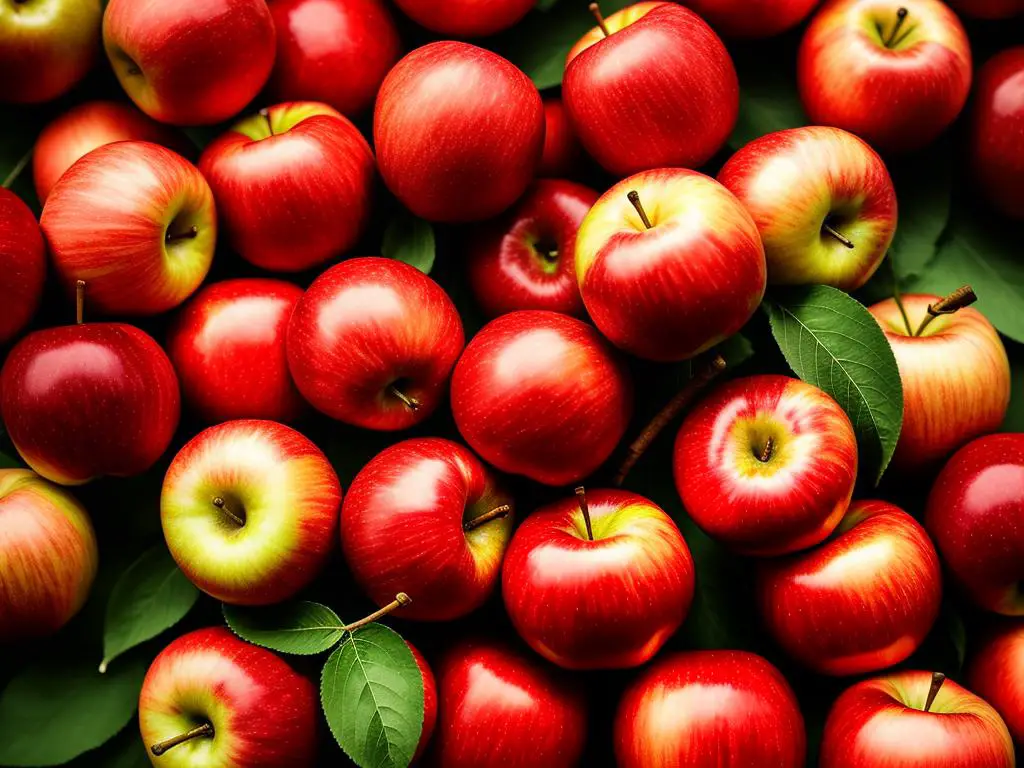
Health Impact and Culinary Uses of Red-Fleshed Apples
What Makes Red-Fleshed Apples Special
Red-fleshed apples tantalize the senses in a way that traditional, white-fleshed apples cannot. Their flesh glows with pigments of red and pink, characteristics that they acquired from wild apple species indigenous to Central Asia. These apples not only showcase stunning aesthetics but they bring to the table multiple health benefits and novel culinary potential, making them a remarkable addition to the apple family.
Health Fortitudes of Red-Fleshed Apples
The red flesh of these apples isn’t just visually intriguing; it also translates to a higher antioxidant content compared to conventional apple varieties. The red color comes from anthocyanins, a type of flavonoid with powerful antioxidant activity.
Anthocyanins contribute immensely to our health, playing roles in heart health, anti-inflammatory responses, and cancer prevention. They alleviate the risk of chronic diseases, reinforce immune functionality, and reduce age-related degenerative diseases. They are also touted for their potential in enhancing memory and cognitive function.
However, the concentration of these beneficial compounds can vary depending on the apple variety. Some red-fleshed varieties like the ‘Redlove’ series have shown to possess significantly higher amounts of anthocyanins.
Safety Measures for Consumption
Eating apples that are red inside is perfectly safe. Besides the conventional actions of washing the fruit thoroughly before consumption, there are no unique precautions necessary for enjoying red-fleshed apples. Their vibrant interior is a natural trait and not indicative of any safety concerns.
Culinary Uses of Red-Fleshed Apples
Red-fleshed apples branch out a novel lineup in the culinary world because they retain their distinctive coloration when cooked. Their exquisite taste, often described as tangy, sweet, or berry-like, expands the flavor profiles of various dishes.
These apples are excellent for fresh consumption, adding a pop of color to salads and charcuterie boards. When juiced, they produce a naturally ruby-hued drink, eliminating the need for artificial coloring.
They also fare well in cooked forms, maintaining their color and robust flavor in baked goods like pies and tarts. The ‘Rosette’ variety, for instance, has exemplary baking qualities that make it a popular choice for apple-flavored confectioneries.
Finally, red-fleshed apples lend themselves beautifully to cider production. The acclaimed ‘Geneva Crab’ variety is often used in artisanal cider production, creating a striking rose-colored beverage.
Concludingly, red-fleshed apples make up a remarkable subgroup of apples, each loaded with an array of nutritional advantages. These apples are not just safe to consume, but their adaptability in a plethora of culinary usage makes them an incredibly beneficial and alluring addition to any dietary practice.
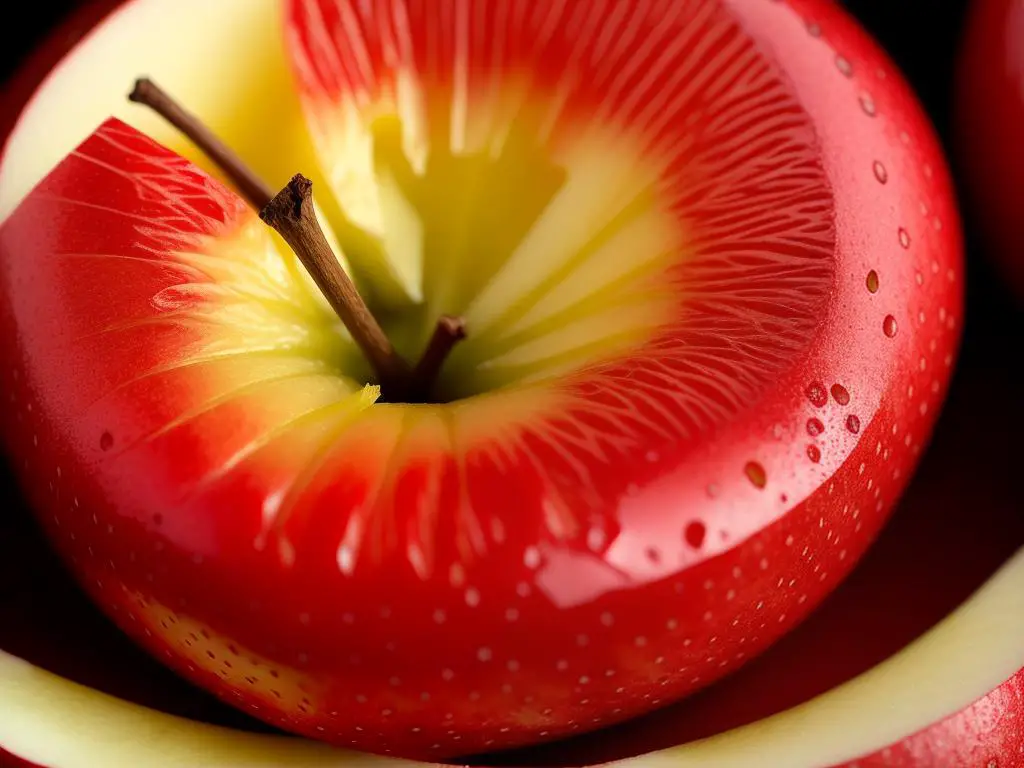
Best Red-Fleshed Apple Varieties
Common Varieties of Red-Fleshed Apples
Apples are beloved, multifaceted fruits savored by many across the globe. The typical apple showcases a white or a light-hued flesh on the inside, yet, there is a special type termed as “red-fleshed apples.” These apples captivate consumers with their beautifully-colored interiors that span from shades of pink to intense red. The altered sweetness or tartness levels of these apples enhance their appeal, making them perfect for a wide array of culinary explorations.
Arkansas Black
Of these red-fleshed varieties, the Arkansas Black is a heritage apple variety known for its dark, waxy exterior that can appear almost black. Contrary to its name, these apples are pronounced with a deep red hue in their flesh. They’re known for their crisp and tart flavor, making them excellent for pies or cider.
Hidden Rose
Next up is the Hidden Rose, a spectacular apple variety with a bright pink to red flesh hidden beneath its light green skin. The flavor profile of Hidden Rose is characterized by its balanced sweetness and tartness. It’s perfect for enjoying fresh, in salads or juicing.
Pink Pearl
The Pink Pearl apples are a treat to the eyes with a light yellow to green skin encasing a vibrant pink-red flesh. Established by American breeder Albert Etter in the 1940s, Pink Pearl is well-regarded for its aromatic scent and delicate, sweet-tart flavor. These apples are great for culinary uses, particularly baking.
Red Devil
Slated as one of the most vibrant red-fleshed apples, Red Devil stems from the UK with a noticeable pink-red blush on its skin and a comparable interior. It’s loved for its sweet and tangy flavor, often boasting a hint of strawberries. Red Devil makes for great eating fruit or dessert enhancer.
Storing and Preserving Red Apples
Red apples, given proper storage, can maintain their freshness for quite a stretch of time. Roughly speaking, these apples will last for merely a few weeks if left at ambient room temperature. However, if they are refrigerated, especially in the crisper drawer, their lifespan can extend between 1 to 2 months.
Preventing sliced apples from turning brown is a vital aspect of storing them. Simply applying a small amount of lemon juice to the cut surfaces can decelerate the process of oxidation. To maximize their freshness, these apple slices should be stored in airtight containers and kept refrigerated.
Freezing is another excellent strategy to preserve your apples for a longer period. You only need to slice your cored apples, optionally peel them, place them in a single layer on a baking sheet, and freeze. Once frozen, transfer them to a freezer bag or airtight container where they can be kept frozen for as long as a year.
When picking apples, whether they are Arkansas Black, Hidden Rose, Pink Pearl, or Red Devil, make sure they are firm to the touch, bear no visible bruises, and emit a fresh apple aroma. Regardless of your cooking requirements or personal taste preferences, these red-fleshed apple varieties will undoubtedly add a unique and delightful touch to your culinary repertoire.
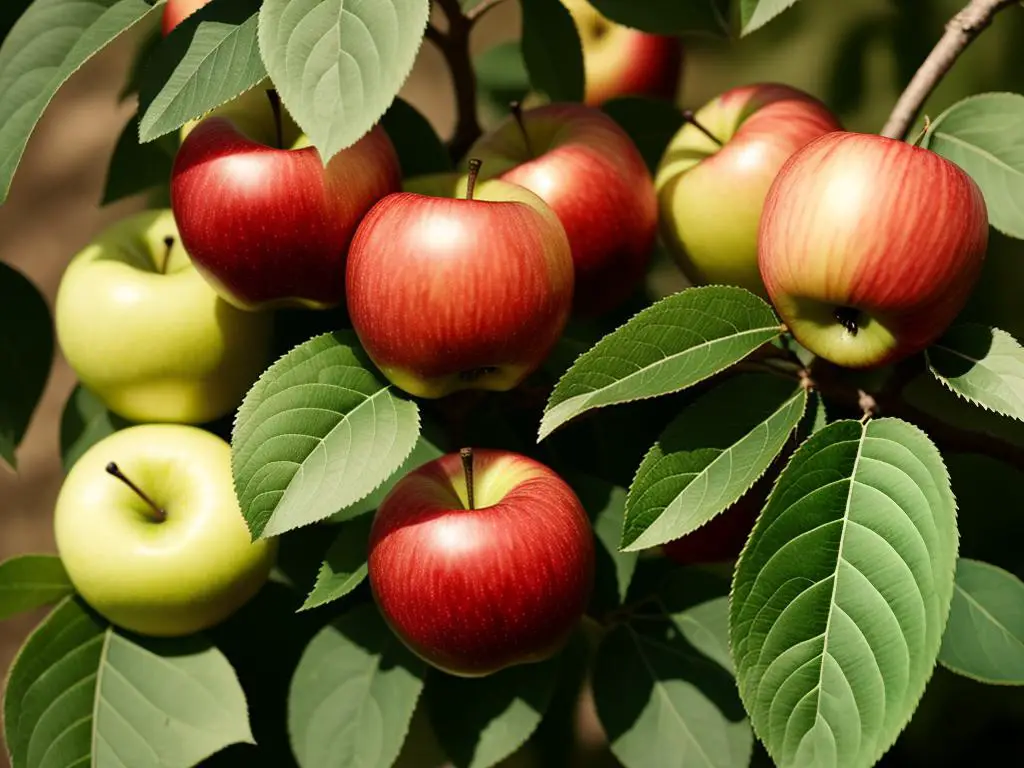
Growing Red-Fleshed Apples
Exploring The World of Red-Fleshed Apples: An Uncommon and Unique Breed
Red-fleshed apples: a rare apple variety that you may not commonly see in your local supermarket or fruit market. These apples are not typically known for their external appearance but hold a unique surprise inside – a brilliant red or pink flesh in stark contrast to their often red, yellow, or green skin. However, their uniqueness isn’t confined to their appearance. These apples also boast a distinctive flavor profile, reminiscent of berries, with a touch of tartness and spice, a refreshing deviation from their more commonly found apple counterparts.
The Apple Capital of the U.S.
Wenatchee, Washington, is considered the apple capital of the United States, processing over 20 billion apples annually. While most of these are your run-of-the-mill reds, greens, and yellows, the region has seen an increase in the cultivation of red-fleshed apples in recent years. Growers in this region work continuously on the development and distribution of this unique apple category, expanding from the local farmers’ markets to the national distribution.
Types of Red-Fleshed Apples
There are several varieties of red-fleshed apples, including the tickled pink, redlove era, and Geneva crab, among others. These apples come in various sizes, flavors, and even shades of red on the inside.
The “Redlove Era” apple, for instance, boasts a deep red skin with an equally mesmerizing deep red flesh. It has a balanced sweet-tart flavor and is usually ready for picking in early autumn.
The “Tickled Pink” apple is another variety that showcases a lovely red blush on the outside and a stunningly vibrant red flesh inside. This apple offers a refreshingly crisp bite and a flavor that combines the taste of a traditional apple with hints of berries.
Growing Conditions for Red-fleshed Apples
Like any apple, red-fleshed apple trees need the right conditions to thrive. These apples prefer cool to cold winter climates and a well-drained soil. Most of these varieties are also disease resistant, an ideal characteristic for home growers.
Given the right care and environment, red-fleshed apple trees can start producing fruit in about three to four years. Usually, trees need to be pruned once a year during the late winter to encourage new growth and larger, healthier apples. With proper care and maintenance, you can expect an abundant harvest of these vibrant and delicious apples.
The Appeal of Red-fleshed Apples
Aside from their aesthetically pleasing appearance, red-fleshed apples offer several benefits to their consumers. They are loaded with anthocyanins, a type of flavonoid that has antioxidant properties. Some of these apples, like the RubyFrost variety, are specifically bred for higher antioxidant levels, offering a healthier snacking option.
In conclusion, red-fleshed apples are a unique take on a classic fruit staple. Their vibrant color, distinct taste, and additional health benefits make them an appealing choice for apple lovers searching for something outside the usual. Whether you’re thinking about growing them or merely trying them out, these apples are certainly worth exploring.
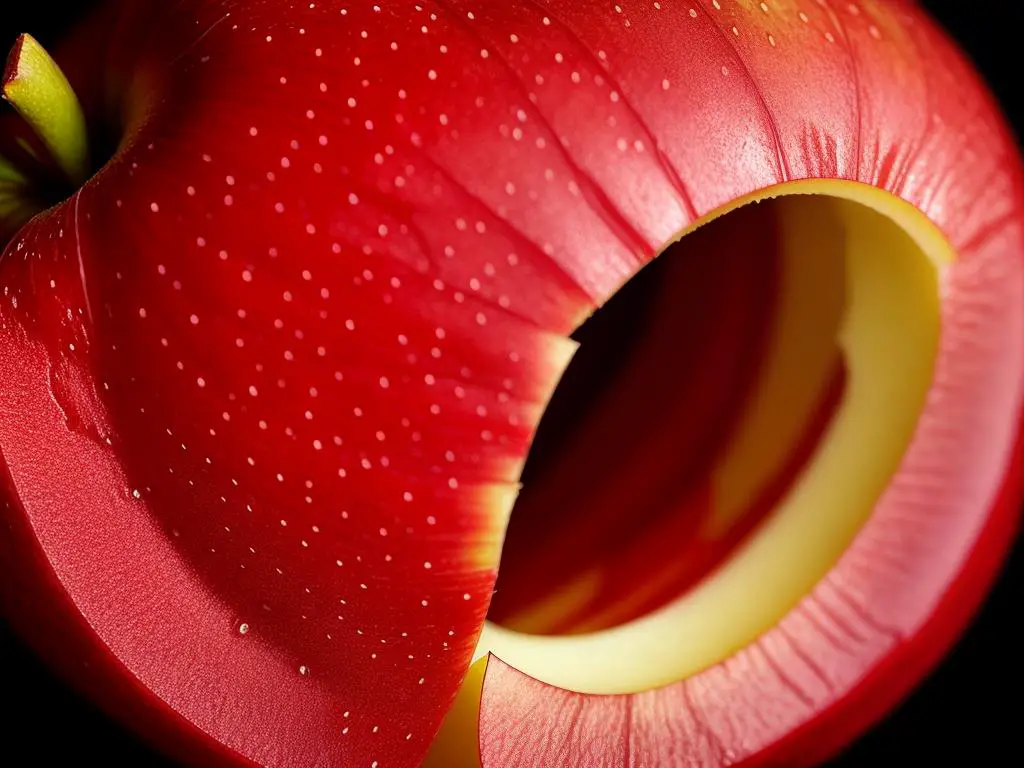
Red-fleshed apples are more than just an intriguing novelty; they are packed with health benefits, offer a variety of culinary applications and present a unique opportunity for apple enthusiasts to grow something out of the ordinary. Scientists and breeders continue to study and develop these red-fleshed apples, further enriching their potential as a nutritional and ornamental fruit. As we get to know more about these apples in the future, they will surely change the way we perceive and appreciate this staple fruit. So next time you bite into an apple, don’t just expect a white interior; dive into the world of red-fleshed apples, and you might just get a delightful surprise.
